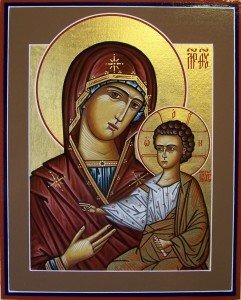 One of the major fasts of our Church is the Entrance of Mary into the Temple. It is celebrated on November 21st of the New (Gregorian) Calendar. I shall deal with this feast again when I return to my presentation on the reason why these major feasts were developed in the Byzantine Church. Since this feast is celebrated next week, I shall share some information about it now.
One of the major fasts of our Church is the Entrance of Mary into the Temple. It is celebrated on November 21st of the New (Gregorian) Calendar. I shall deal with this feast again when I return to my presentation on the reason why these major feasts were developed in the Byzantine Church. Since this feast is celebrated next week, I shall share some information about it now.
This feast, like other Marian feasts, traces its origin to the tradition of the Church and certain well-accepted apocryphal writings, especially these two: Proto-Evangelium of James (i.e., probably written about AD 145 and expands backward in time the infancy stories contained in the Gospels of Matthew and Luke, and presents a narrative concerning the birth and upbringing of Mary) and the Pseudo-Evangelium of Matthew (i.e., probably written between 600 and 625 AD and a part of the New Testament apocrypha. It is one of a genre of Infancy Gospels that seeks to fill out the details of the life of Jesus up to the age of 12 which are briefly given in the Gospels of Matthew and Luke).
Allusions are made to this feast in the fifth century; however, it took several hundred years before it was universally observed in the East. From the sermons of several Fathers, it can be inferred that the feast of the Entrance was established in the eighth century.
The Sinai Gospel of the eighth century, which Emperor Theodosius III (715-717) donated to the Sinai monastery, mentions the feast of the Entrance among the twelve feasts. This feast is found in the Greek Menaion (Greek: Μηναῖον and Slavonic Минеѧ) is the liturgical book used by the Eastern Church containing the propers for fixed dates of the calendar year, [i.e. feasts not dependent of the date of Easter]. The Menaion is the largest volume of the propers for the Byzantine Ritual and is used at nearly all the daily services). It finally became universally recognized and observed in the ninth century.
What spiritual lesson does this feast offer us? First of all, it speaks to us of the joyful sacrifice of Joachim and Anna. They themselves bring their daughter to the Temple and offer her to the service of God. They did this in thanksgiving for the gift of Mary. They had been sterile for many years and could not have children.
Second, Mary gladly obeys the voice of God and her parents and gives herself voluntarily to service in the Tem-ple, despite the fact that she probably did not fully understand what her par-ents were doing.
Both Mary and her parents demonstrate how a “spirit of sacrifice” and acceptance of one’s life can lead to greatness. The acceptance of life’s challenges leads to greatness.
